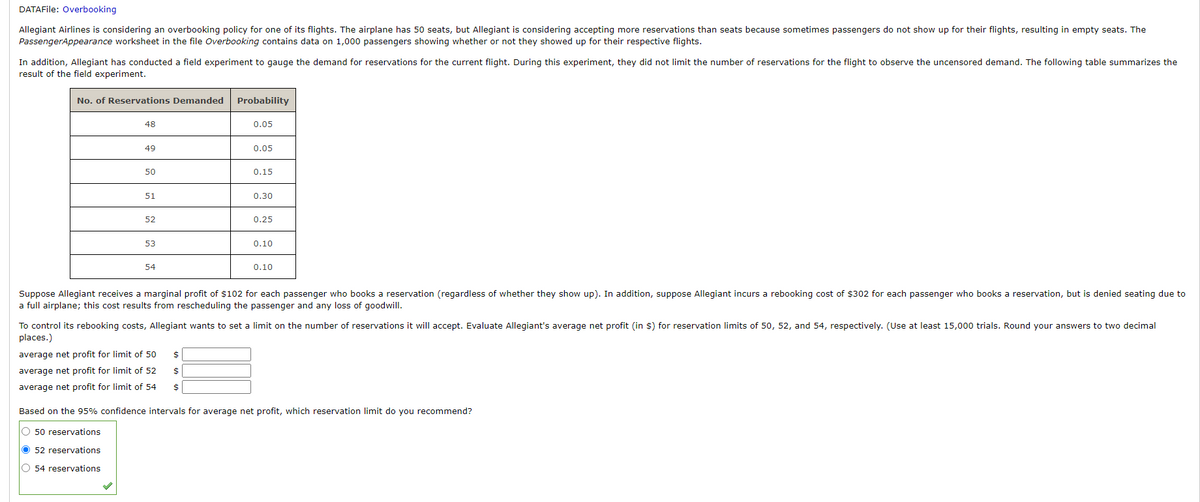DATAFile: Overbooking Allegiant Airlines is considering an overbooking policy for one of its flights. The airplane has 50 seats, but Allegiant is considering accepting more reservations than seats because sometimes passengers do not show up for their flights, resulting PassengerAppearance worksheet in the file Overbooking contains data on 1,000 passengers showing whether or not they showed up for their respective flights. empty seats. The In addition, Allegiant has conducted a field experiment to gauge the demand for reservations for the current flight. During this experiment, they did not limit the number of reservations for the flight to observe the uncensored demand. The following table summarizes the result of the field experiment. No. of Reservations Demanded Probability 48 0.05 49 0.05 50 0.15 51 0.30 52 0.25 53 0.10 54 0.10 whether they show up). In addition, suppose Allegiant incurs a rebooking cost of $302 for each passenger who books a reservation, but is denied seating due to Suppose Allegiant receives a marginal profit of $102 for each passenger who books a reservation (regardless a full airplane; this cost results from rescheduling the passenger and any loss of goodwill. To control its rebooking costs, Allegiant wants to set a limit on the number of reservations it will accept. Evaluate Allegiant's average net profit (in s) for reservation limits of 50, 52, and 54, respectively. (Use at least 15,000 trials. Round your answers to two decimal places.) average net profit for limit of 50 average net profit for limit of 52 average net profit for limit of 54 Based on the 95% confidence intervals for average net profit, which reservation limit do you recommend? O 50 reservations O 52 reservations O 54 reservations
DATAFile: Overbooking Allegiant Airlines is considering an overbooking policy for one of its flights. The airplane has 50 seats, but Allegiant is considering accepting more reservations than seats because sometimes passengers do not show up for their flights, resulting PassengerAppearance worksheet in the file Overbooking contains data on 1,000 passengers showing whether or not they showed up for their respective flights. empty seats. The In addition, Allegiant has conducted a field experiment to gauge the demand for reservations for the current flight. During this experiment, they did not limit the number of reservations for the flight to observe the uncensored demand. The following table summarizes the result of the field experiment. No. of Reservations Demanded Probability 48 0.05 49 0.05 50 0.15 51 0.30 52 0.25 53 0.10 54 0.10 whether they show up). In addition, suppose Allegiant incurs a rebooking cost of $302 for each passenger who books a reservation, but is denied seating due to Suppose Allegiant receives a marginal profit of $102 for each passenger who books a reservation (regardless a full airplane; this cost results from rescheduling the passenger and any loss of goodwill. To control its rebooking costs, Allegiant wants to set a limit on the number of reservations it will accept. Evaluate Allegiant's average net profit (in s) for reservation limits of 50, 52, and 54, respectively. (Use at least 15,000 trials. Round your answers to two decimal places.) average net profit for limit of 50 average net profit for limit of 52 average net profit for limit of 54 Based on the 95% confidence intervals for average net profit, which reservation limit do you recommend? O 50 reservations O 52 reservations O 54 reservations
Glencoe Algebra 1, Student Edition, 9780079039897, 0079039898, 2018
18th Edition
ISBN:9780079039897
Author:Carter
Publisher:Carter
Chapter10: Statistics
Section10.6: Summarizing Categorical Data
Problem 28PPS
Related questions
Question

Transcribed Image Text:DATAFile: Overbooking
Allegiant Airlines is considering an overbooking policy for one of its flights. The airplane has 50 seats, but Allegiant is considering accepting more reservations than seats because sometimes passengers do not show up for their flights, resulting in empty seats. The
PassengerAppearance worksheet in the file Overbooking contains data on 1,000 passengers showing whether or not they showed up for their respective flights.
In addition, Allegiant has conducted a field experiment to gauge the demand for reservations for the current flight. During this experiment, they did not limit the number of reservations for the flight to observe the uncensored demand. The following table summarizes the
result of the field experiment.
No. of Reservations Demanded
Probability
48
0.05
49
0.05
50
0.15
51
0.30
52
0.25
53
0.10
54
0.10
Suppose Allegiant receives a marginal profit of $102 for each passenger who books a reservation (regardless of whether they show up). In addition, suppose Allegiant incurs a rebooking cost of $302 for each passenger who books a reservation, but is denied seating due to
a full airplane; this cost results from rescheduling the passenger and any loss of goodwill.
To control its rebooking costs, Allegiant wants to set a limit on the number of reservations it will accept. Evaluate Allegiant's average net profit (in $) for reservation limits of 50, 52, and 54, respectively. (Use at least 15,000 trials. Round your answers to two decimal
places.)
average net profit for limit of 50
average net profit for limit of 52
average net profit for limit of 54
Based on the 95% confidence intervals for average net profit, which reservation limit do you recommend?
50 reservations
O 52 reservations
54 reservations
Expert Solution
This question has been solved!
Explore an expertly crafted, step-by-step solution for a thorough understanding of key concepts.
This is a popular solution!
Trending now
This is a popular solution!
Step by step
Solved in 5 steps with 5 images

Recommended textbooks for you

Glencoe Algebra 1, Student Edition, 9780079039897…
Algebra
ISBN:
9780079039897
Author:
Carter
Publisher:
McGraw Hill

Glencoe Algebra 1, Student Edition, 9780079039897…
Algebra
ISBN:
9780079039897
Author:
Carter
Publisher:
McGraw Hill